Casta Diva from Norma by Vincenzo Bellini
Casta Diva from Norma by Vincenzo Bellini
Fromental Halévy, French composer of the opera La Juive, claimed he would have given away all his works if he could have composed just one aria, 'Casta diva'. The aria has been a signature piece for famous sopranos such as Maria Callas, Joan Sutherland, Renee Fleming, Anna Netrebko and Angela Gheorgiu. It is one of the most exquisite gems in the bel canto repertoire.
Casta Diva
Norma is a tragedia lirica or opera in two acts by Vincenzo Bellini with libretto by Felice Romani after Norma, ossia L'infanticidio (Norma, or The Infanticide) by Alexandre Soumet.

Vincenzo Bellini
Bellini insisted on spending a few months on the composition of his works. At the time of his sudden death in 1835, Bellini had composed a mere ten operas. Nonetheless, the last of Bellini's operas, La Sonnambula, Norma, and I Puritani are undisputed masterpieces, with Norma being more renowed due to its famous aria ‘Casta Diva.’
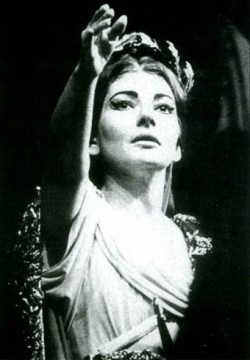
Casta Diva
Synopsis
Place: Gaul.
Time: Early times of Roman conquest of Gaul.
Act 1
The grove.
A secret love unites the seeress Norma with Pollione, the Roman proconsul, by whom she has borne two children. But Pollione has grown tired of the aging druidess and has fallen in love with Adalgisa, a young temple virgin. Despite Adalgisa's piety and virtue, she agrees to flee to Rome with Pollione. Adalgisa innocently tells Norma of her love, and Norma curses Pollione for his treachery.
Act 2
Norma’s apartment.
Norma is about to kill her children, but her love for her children finally confides them to the care of Adalgisa. When Pollione comes to take Adalgisa from the temple, Norma denounces him and he is seized by the Druids, after having refused to give up Adalgisa. Norma proclaims herself equally guilty with him. The pyre is lighted, and ascending it, Norma dies with her lover.
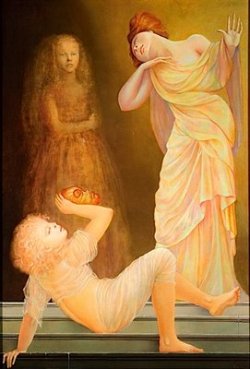
Leonor Fini - Casta Diva
In a letter dated September 1, 1831, Bellini wrote to the soprano Giuditta Pasta that "Romani believes will be very effective, and absolutely ideal for your encyclopedic character, because that is the kind of character Norma has". Pasta was a soprano considered among the greatest of opera singers, to whom the 20th-century soprano Maria Callas was compared.
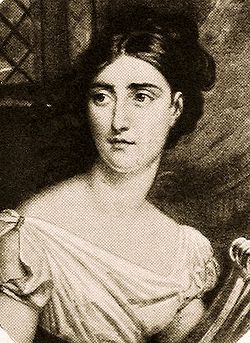
Giuditta Pasta
Premiered on December 26, 1831, at La Scala in Milan, the opera was far from being an instantaneous success. Even Bellini considered it a fiasco. Overworked at the dress rehearsal earlier that day, the singers, including Giuditta Pasta suffered from serious intonation problems. Fortunately, the cast managed to rally together for the following performance. The critics were overwhelmed and the cast was granted thunderous applause. Norma had assumed its rightful place in the repertoire.
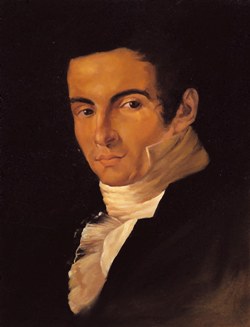
Vincenzo Bellini
The famous aria, ‘Casta Diva’ deserves closer inspection in order to grasp its stunning beauty and Bellini's melodic genius.
The aria is divided into three parts:
1) the main melody sung solo by Norma
2) the choir, which breaks quietly into a chorus and above which Norma passionately sings an ornamented line in the high register;
3) reprise of the opening solo melody on a new text with the addition of syllabic punctuation by the choir.
The short notes of the aria serve as elegant ornaments, allowing the energy contained in the longer note values to finally be released. They also enable the line to land leisurely on the next long note, thus better projecting the following tonic accent. Bellini has therefore realized a successful marriage between notated music and the natural musicality of the Italian language. The first few bars of the aria provide strong evidence of this relationship. In the phrase "Casta Diva, che inargenti," the syllables "Ca," "Di," and "gen" are each given a long note on the first beat of the measure. Such awareness of prosody is certainly not exclusive to Bellini. However, the composer distinguishes himself from his contemporaries and his predecessors by the discreet meandering of the melismas, which inescapably carry the listener to the next tonic accent on the following strong beat.

Casta Diva, score
It is also important to emphasize the remarkable command with which Bellini has planned his registers. The aria begins in the low-medium range of the soprano voice on an A natural. Two measures late, the melody leisurely falls to the low F, only to surprisingly reemerge up to the high D on the staff. Bellini stays in the medium range during the second phrase "queste sacre antiche piante" keeping this same D as the highest pitch. The third phrase, "a noi volgi il bel sembiante," is when the composer decides to orchestrate a gradual rise in register spanning four complete measures. This ascension eventually leads in steps to a high A, repeated with intensity, then resolves itself with force on a B fiat, the highest note and undisputed climax of the aria. Bellini then releases all this energy with a dramatic descent spanning only two measures, from the high B fiat down to the low F. While it had taken a little more than four measures to reach the apex of the melody, Bellini took a bit less than half of this space to cover the complete register of the voice and smoothly return back to the opening register.

Vincenzo Bellini
Once the low F has been reached again, the choristers begin the second section of the piece, repeating the complete text of the first section. Norma joins them two measures later with chromatic melismas in the high register, the virtuosity of which requires absolute vocal control from the soloist in order to properly convey the moment's graceful and solemn character.
The third section repeats the same music as the first, this time with the choir striking the pulse together with the lower strings. The aria ends with an impressive out-of-tempo cadenza, a chromatic descent once again covering the complete ambitus of the voice, in a time frame spanning less than a measure.
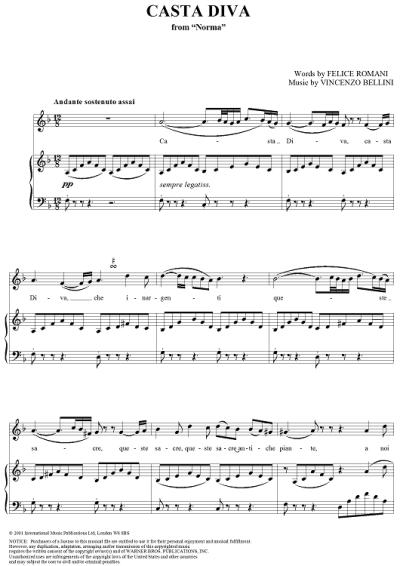
Casta Diva, score
Many singers have attempted the role of Bellini's tormented Druid priestess, with varying degrees of success. The most prolific Norma of the postwar period was Maria Callas, with 89 stage performances along with two studio recordings (made in 1954 and 1960). Bellini doesn’t make life easy for the singers. There’s never any doubling of the vocal line by the orchestra so the singer is very exposed. This doesn’t bother Maria Callas. In the 1960s, two very different performers started donning the Druidess's robes: the Australian Dame Joan Sutherland and the Turk Leyla Gencer. Following Sutherland's 1964 debut in the title role, Pavarotti called her "the greatest female voice of all time".

Maria Callas
Casta Diva Italian Lyrics
Casta Diva, che inargenti queste sacre antiche piante, a noi volgi il bel sembiante senza nube e senza vel... Tempra, o Diva, tempra tu de’ cori ardenti tempra ancora lo zelo audace, spargi in terra quella pace che regnar tu fai nel ciel...

Vincenzo Bellini
Casta Diva English Translation
Pure Goddess, whose silver covers These sacred ancient plants, we turn to your lovely face unclouded and without veil... Temper, oh Goddess, the hardening of you ardent spirits temper your bold zeal, Scatter peace across the earth Thou make reign in the sky...

Vincenzo Bellini
Last Updated (Thursday, 19 March 2015 16:30)








